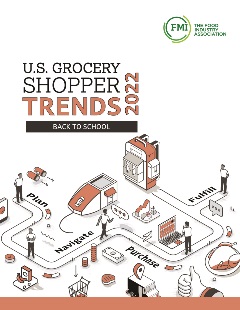Arlington, VA—FMI—The Food Industry Association today releases the fifth edition of the U.S. Grocery Shopper Trends 2022 series focused on Back to School and finds 90% of shoppers are concerned about some aspect of food accessibility, with 61% concerned about rising prices specifically—an increase of eight percentage points since February 2022. However, even in this inflationary environment, shoppers feel they have at least some degree of control over their finances, particularly when it comes to their grocery budgets (86%).
the U.S. Grocery Shopper Trends 2022 series focused on Back to School and finds 90% of shoppers are concerned about some aspect of food accessibility, with 61% concerned about rising prices specifically—an increase of eight percentage points since February 2022. However, even in this inflationary environment, shoppers feel they have at least some degree of control over their finances, particularly when it comes to their grocery budgets (86%).
“Our research substantiates that the food industry offers safe, healthy, quality foods, such as store brand products, at affordable price points and provides shoppers other helpful resources to stretch their grocery budgets, helping meet their household’s specific food needs,” shared Leslie Sarasin, president and CEO of FMI.
Shoppers Face Rising Prices Across Their Household Budgets
Shoppers’ worries about rising prices are focused on essential items, including gas (77%), food (72%) and housing (59%) costs. Households with children are particularly concerned about rising prices on school supplies (64%) and clothing (65%). Even though shoppers say they are feeling pinched, they do express control over aspects of their household budget, particularly eating out (91%), grocery shopping (86%) and, for households with children, childcare (87%).
Shoppers Tighten Their Belts (and Wallets)
Shoppers report weekly grocery spend totals of $136, which is $12 lower than February 2022. This is partially a seasonal effect, with consumers eating out more during summer months, but it also indicates belt-tightening behaviors. Shoppers seem to believe they are succeeding at bringing their grocery spending under control, hitting a lower ongoing weekly total, as they adjust their overall household budgets.
Americans Adjust Their Grocery Shopping Habits
Shoppers are finding ways to cope with rising food prices by looking for deals (49%), buying more store brands (41%), buying fewer items (37%), buying in bulk (23%) and making increased use of store loyalty programs (22%). Consumers are also seeing different benefits from shopping in-store or online. Customers indicate that while shopping in a physical store, they can make adjustments at the shelf (61%) and save on shipping/delivery (57%). When grocery shopping online, shoppers report they can better monitor basket size (64%) and save on gas (62%).
The U.S. Grocery Shopper Trends: Back to School report includes additional information regarding shoppers’ concerns about COVID-19 and its long-term impact, details on the ways rising food prices are impacting food insecure households, restaurant spending versus grocery spending, and much more. To download this latest report and find other reports from the U.S. Grocery Shopper Trends 2022 series, visit www.FMI.org/GroceryTrends.
For Media:
- Contact media@fmi.org for a gratis copy of the U.S. Grocery Shopper Trends 2022: Back To School.
 Industry Topics address your specific area of expertise with resources, reports, events and more.
Industry Topics address your specific area of expertise with resources, reports, events and more.
 Our Research covers consumer behavior and retail operation benchmarks so you can make informed business decisions.
Our Research covers consumer behavior and retail operation benchmarks so you can make informed business decisions.
 Events and Education including online and in-person help you advance your food retail career.
Events and Education including online and in-person help you advance your food retail career.
 Food Safety training, resources and guidance that help you create a company food safety culture.
Food Safety training, resources and guidance that help you create a company food safety culture.
 Government Affairs work — federal and state — on the latest food industry policy, regulatory and legislative issues.
Government Affairs work — federal and state — on the latest food industry policy, regulatory and legislative issues.
 Get Involved. From industry awards to newsletters and committees, these resources help you take advantage of your membership.
Get Involved. From industry awards to newsletters and committees, these resources help you take advantage of your membership.
 Best practices, guidance documents, infographics, signage and more for the food industry on the COVID-19 pandemic.
Best practices, guidance documents, infographics, signage and more for the food industry on the COVID-19 pandemic.
